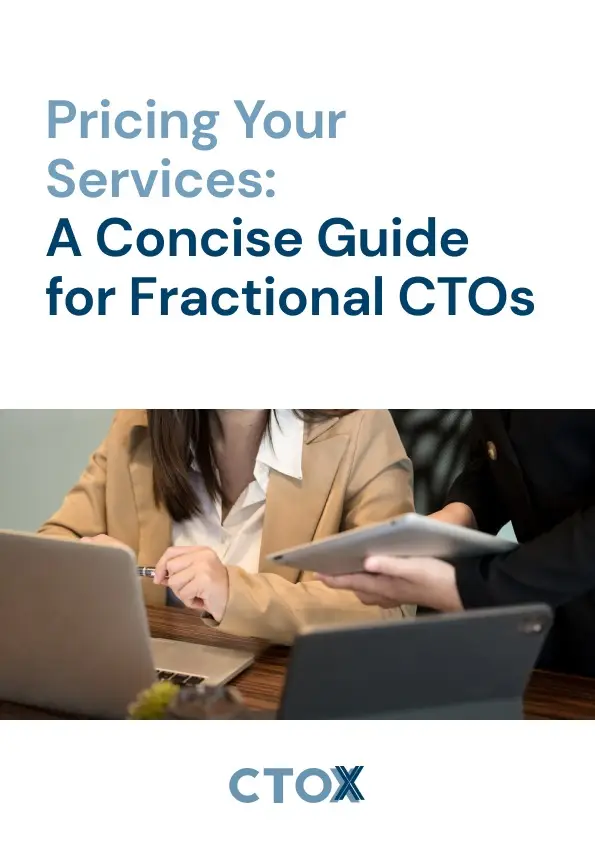Want to save over $360,000 annually while getting top-tier tech leadership? Fractional CTOs offer a cost-effective alternative to full-time CTOs, delivering high-level leadership without the full-time price tag. Here’s what you need to know:
- Cost Savings: Fractional CTOs cost $3,000–$15,000/month, compared to a full-time CTO’s annual cost of $486,874 on average (including salary and benefits).
- Flexibility: Pay only for the services you need – project-based or monthly retainers.
- Proven Impact: Companies using fractional tech leadership report 18% higher revenue growth, 15% greater profitability, and faster project completion.
- Non-Financial Benefits: Access to diverse expertise, faster implementation, and no long-term commitments.
Quick Comparison
| Aspect | Fractional CTO | Full-time CTO |
|---|---|---|
| Cost Structure | $3,000–$15,000/month | ~$486,874/year (salary + benefits) |
| Time Commitment | Flexible, project-based | Full-time (40 hours/week) |
| Strategic Focus | Targeted initiatives | Comprehensive oversight |
| Availability | Scheduled engagement | Full-time presence |
Fractional CTOs are ideal for startups and growing businesses looking to scale, streamline operations, or implement digital transformations without overspending. Ready to see how fractional tech leadership can work for you? Let’s dive in.
Fractional CTO Explained: Maximize Your Tech Strategy Without Full-Time Overhead
ROI Analysis Methods
This section outlines how we evaluate the ROI of fractional tech leadership.
Research Sources
Our analysis is built on data from trusted sources, ensuring accuracy and depth:
- Industry surveys and market research from top consulting firms
- Financial performance data from companies using fractional leadership
- Case studies from the ROI Institute
- Direct feedback from businesses leveraging fractional tech leadership
This framework forms the foundation of our approach.
Performance Metrics
We focus on specific KPIs to measure the impact of fractional tech leadership:
| Metric Category | Key Indicators | Measurement Method |
|---|---|---|
| Cost Savings & Revenue | Cost savings, Revenue growth | Comparing pre- and post-engagement results |
| Technical Efficiency | Project completion rates, Development speed | Sprint metrics, project timelines |
| Business Outcomes | Digital transformation success, Innovation metrics | Milestone tracking, ROI per initiative |
| Team Performance | Technical debt reduction, Team productivity | Code quality, sprint velocity |
Small and medium-sized enterprises (SMEs) with strong tech leadership have shown 18% higher revenue growth and 15% greater profitability compared to their competitors.
Comparison Framework
To compare fractional and full-time tech leadership, we use a structured evaluation process:
We calculate the total cost of ownership – factoring in compensation, overhead, and training – while analyzing value through strategic initiative success and team improvements. Both quantitative and qualitative factors contribute to the overall ROI assessment.
Cost Components:
- Direct compensation and benefits
- Overhead and operational costs
- Training and onboarding expenses
- Long-term commitment considerations
Value Indicators:
- Strategic initiative completion rates
- Technology stack improvements
- Team performance enhancements
- Risk mitigation outcomes
ROI Factors:
- Direct cost savings
- Revenue growth
- Operational efficiency gains
- Strategic value contributions
"Objectives are powerful drivers of success." – ROI Institute
This detailed approach helps businesses make informed staffing decisions that align with their goals.
Cost vs. Benefit Results
Let’s dive into the numbers and outcomes that highlight the financial and operational perks of fractional tech leadership.
Salary and Cost Differences
When comparing fractional and full-time tech leadership, the cost savings are hard to ignore. Here’s a breakdown of the expenses:
| Position Type | Annual Base Cost | Additional Costs (bonus + benefits) | Total Annual Investment |
|---|---|---|---|
| Full-Time CTO | $303,874 | $183,000 | $486,874 |
| Fractional CTO (25% time) | $124,800 | None | $124,800 |
By choosing a fractional CTO, companies can save over $362,000 annually. Full-time CTO costs include a base salary ranging from $223,961 to $387,718, along with a median bonus of $80,000 and benefits valued at $103,000.
Sometimes, Fractional CTOs may charge between $180 and $400 per hour, meaning businesses only pay for the precise services they need, avoiding unnecessary overhead.
Measured Business Results
Real-world results back up the cost analysis. For example, in 2020, a sustainable electronics startup leveraged fractional tech leadership and saw:
- A 25% reduction in infrastructure costs
- A 30% faster product development timeline
- Streamlined technical documentation processes
Fractional leadership also lets companies adapt their technology investments as they scale. Organizations using fractional CTOs report quicker product launches, lower technical debt, better resource allocation, and more productive teams. These operational gains pair with strategic advantages, which we’ll explore next.
Non-Financial Benefits
Beyond the numbers, fractional tech leadership offers strategic perks that can shape a company’s future.
These leaders bring diverse industry experience, expertise in emerging technologies, and access to extensive professional networks. They can implement best practices right away, provide scalable engagement without long-term commitments, and offer an unbiased, external perspective. Plus, they’re equipped to respond quickly to changes in the market.
For companies with annual revenues exceeding $1 million, fractional tech leadership delivers not just cost savings but also the flexibility and expertise needed to make smarter technology investments. It’s a practical choice for businesses aiming to stay agile while achieving their goals.
sbb-itb-4abdf47
Company Examples
Real-world examples highlight how fractional tech leadership can deliver measurable returns on investment.
Small Business Cost Reduction
In 2020, WiserBrand shared a case study about a sustainable electronics startup facing challenges as it tried to scale. The company needed experienced tech leadership but couldn’t afford the expense of hiring a full-time CTO. Instead, they brought in a Fractional CTO.
This part-time leader evaluated the startup’s tech infrastructure, created a roadmap for improvement, and introduced clear documentation processes. The result? Lower costs and faster product development, proving how fractional tech leadership can help small businesses save money while speeding up critical processes.
Startup Growth Example
Stripe’s early success offers another compelling example. In 2010, the company brought on Greg Brockman – who had been Twitter’s CTO – as a part-time technology leader. Brockman played a key role in strengthening Stripe’s technical foundation. He designed a powerful server architecture, introduced scalable systems, mentored the engineering team, and promoted a collaborative culture.
Thanks to these efforts, Stripe scaled its platform to handle billions in transactions securely and efficiently. This part-time leadership approach directly contributed to long-term growth, aligning perfectly with the ROI framework.
Success Patterns
Looking at various successful fractional CTO engagements, three strategies stand out as essential for delivering strong ROI:
- Strategic Planning: Companies see the best outcomes when they analyze their tech needs, set clear goals, and align technology investments with broader business objectives.
- Effective Communication: Regular check-ins, clear roles, performance metrics, and open communication channels ensure smooth implementation.
- Knowledge Sharing: Fractional CTOs help organizations by sharing expertise, planning for the future, and encouraging collaboration across departments.
These strategies form the foundation for maximizing the value of fractional tech leadership. The examples above, combined with these success patterns, provide a clear roadmap for leveraging part-time tech leadership effectively. The next section will explore actionable steps in more detail.
Results and Action Steps
Data Overview
Recent analysis highlights the cost-effectiveness of fractional tech leadership. Fractional CTOs typically charge 60-70% less than full-time executives while providing top-tier strategic guidance. Here’s a breakdown of typical costs:
| Engagement Type | Cost Range | Typical Duration |
|---|---|---|
| Hourly Rate | $150–$500 | As needed |
| Monthly Retainer | $3,000–$15,000+ | 3–12 months |
| Project-Based | $5,000–$50,000+ | Based on scope |
With global IT spending expected to surpass $5 trillion in 2024, many organizations are turning to fractional leadership to maximize their tech investments. For example, a manufacturing company reduced downtime by 25% after adopting IoT monitoring systems recommended by their fractional CTO.
Success Requirements
To get the most out of a fractional CTO, preparation is key. Companies that see the best results focus on:
- Documenting strategies, architectures, and roadmaps to provide clear direction.
- Establishing effective communication protocols to ensure quick implementation.
- Aligning performance metrics with business goals to track success.
This groundwork helps fractional CTOs quickly understand the business context and deliver results.
"Success with a fractional CTO starts with good planning. First, outline your specific technology needs and goals – this helps focus their efforts on high-impact areas. Next, set up regular check-ins and communication channels to keep them connected with company updates and project progress. Make sure to define clear roles and responsibilities, both for the CTO and how they’ll work with your existing team members. By taking these steps upfront, you’ll create an environment where the fractional CTO can contribute effectively and help achieve your technology objectives."
With these foundational practices in place, the next step is to implement a structured approach to leverage fractional tech leadership effectively.
Implementation Steps
-
Assessment and Planning
Start by evaluating your current technology challenges and identifying areas where expert guidance is needed. Document your goals, key issues, and expected outcomes. Use this information to create a realistic budget based on potential ROI. -
Selection and Onboarding
Look for candidates through specialized networks or job boards that cater to fractional roles. During interviews, prioritize experience relevant to your needs and assess their approach to fractional work."Engineers are problem solvers– if you give them problems, not instructions, they’re capable of being highly autonomous. I find that people are also happier and more engaged when they’re given that level of trust, respect, and responsibility."
-
Execution Framework
Set up a clear structure to guide the collaboration. Include:- Specific deliverables and deadlines.
- Regular meetings with the leadership team.
- Tools for asynchronous communication.
- Progress tracking systems.
- Ongoing performance reviews.
This structured approach ensures that strategic plans are translated into measurable outcomes.
Conclusion
Data analysis highlights the financial and operational advantages of fractional tech leadership. For instance, research shows that a mid-sized SaaS company can save between $115,000 and $271,000 annually by choosing a fractional CTO instead of hiring a full-time executive.
But it’s not just about cutting costs. Fractional CTOs bring specialized expertise that can make a real difference. As Gun.io puts it:
"Companies that bring in an experienced fractional CTO – someone with strategic vision, leadership skills, and access to a vast network of industry connections – regularly outperform those that simply demand longer hours from their teams."
Here’s a quick breakdown of the key benefits:
| Benefit Category | Measurable Impact |
|---|---|
| Cost Efficiency | Far more affordable than a full-time CTO’s salary |
| Time to Value | Immediate results compared to a 3–6 month onboarding time |
| Risk Reduction | Reduced risk with a flexible engagement model |
| Strategic Value | Access to broad industry expertise and strong networks |
This approach offers a clear edge for startups and growing companies. By leveraging fractional tech leadership, businesses gain access to senior-level expertise without overextending their budgets. It’s an ideal solution for organizations looking to scale, adopt cutting-edge technologies, or drive digital initiatives. The evidence shows that fractional CTOs are a smart, cost-effective option that delivers measurable results while minimizing risks.







